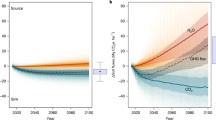Abstract
Most existing agricultural lands have been in production for sufficiently long periods that C inputs and outputs are nearly balanced and they are neither a major source nor sink of atmospheric C. As population increases, food requirements and the need for more crop land increase accordingly. An annual conversion of previously uncultivated lands up to 1.5 × 107 hectares may be expected. It is this new agricultural land which suffers the greatest losses of C during and subsequent to its conversion. The primary focus for analysis of future C fluxes in agroecosystems needs to be on current changes in land use and management as well as on direct effects of CO2 and climate change. A valid assessment of C pools and fluxes in agroecosystems requires a global soils data base and comprehensive information on land use and management practices. A comprehensive effort to assemble and analyze this information is urgently needed.
Similar content being viewed by others
References
Bouwman, A.F.: 1990a, Global distribution of the major soils and land cover types, in: Bouwman, A.F. (ed),Soils and the Greenhouse Effect, John Wiley & Sons, New York, pp. 33–59.
Bouwman, A.F.: 1990b, Exchange of greenhouse gases between terrestrial ecosystems and the atmosphere, in: Bouwman, A.F. (ed),Soils and the Greenhouse Effect, John Wiley & Sons, New York, pp. 61–127.
Brown, S., Hall, C.A.S., Knabe, W., Raich, J., Trexler, M.C., and Woomer, P.: (this volume).Tropical forests: Their past, present, and potential future role in the terrestrial carbon budget.
Buringh, P.: 1984, Organic carbon in soils of the world, in: Woodwell, G.M. (ed),he Role of Terrestrial Vegetation in the Global Carbon Cycle, SCOPE 23, John Wiley & Sons, 247 p.
CAST: 1992,Task Force Report No. 119, Council for Agricultural Science and Technology, Ames, Iowa. 96 p.
Crosson, P.R.: 1992,United States Agriculture and Environment: Perspective in the next 20 years. U.S. Environmental Protection Agency (in press).
Duxbury, J.M., Harper, L.A. and Mosier, A.R.: 1993, Contributions of agroecosystems to global climate change, in: Harper, L.A., Mosier, A.R., Duxbury, J.M. and Rolston, D.E. (eds),Agricultural Ecosystem Effects on Trace Gases and Global Climate Change. ASA Special Publication Number 55,American Society of Agronomy, Inc., Madison, Wisconsin, pp. 1–18.
Eswaran, H., Van Den Berg, E. and Reich, P.: 1993,Soil Sci. Soc. Am. J. 57, 192–194.
Flach, K., Barnwell, T.O. and Crosson, P.: (in press), Impacts of agriculture on soil organic matter in the United States, in: Paul, E.A. and Elliott E.T. (eds),Soil Organic Matter in Temperate Agroecosystems, Lewis Press.
Houghton, R.A., Skole, D.L. and Lefkowitz, D.S.: 1977,Forest Ecology and Management 38, 173–199.
Isaksen, I.S.A, Ramaswamy V., Rodhe H. and Wigley T.M.L: 1992 Radiative Forcing of Climate, in: Houghton J.T., Callander, B.A. and Varney S.K. (eds),Climate Change 1992, Cambridge University Press, pp. 51–67.
Kimble, J., Cook, T. and Eswaran, H.: 1990, Organic matter in soils of the tropics, in: Proc. Symp. Characterization and role of organic matter in different soils. Int. Congr. Soil Sci. 14th, Kyoto, Japan. 2–18 Aug. 1990. ISSS, Wageningen, the Netherlands.
Lee, J., Phillips, D. and Lin, R.: 1993,The effects of trends in tillage practices on erosion and carbon content of soils in the U.S. corn belt.
Leggett, J., Pepper, W.J. and Swart R.J.: 1992, Emissions Scenarios for the IPCC: an Update, in: Houghton, J.T., Callander, B.A. and Varney, S.K. (eds),Climate Change 1992, Cambridge University Press, pp. 73–95.
McElroy, M.B., Wolfsy, S.C. and Yung, Y.L.: 1977,Philosophical Transactions of the Royal Society of London,277, 159–181.
Mosier, A.R., Schimel, D.S., Valentine, D., Bronson, K. and Parton, W.J.: 1991,Nature 350, 330–332.
Ojima, D.S., Valentine, D.W., Mosier, A.R., Parton, W.J. and Schimel, D.S.: 1993,Chemosphere 26, 675–685.
Sampson, N.: 1993,Biomass management and energy.
Sauerbeck, D.: 1993,CO 2-Emission from Agriculture: Sources and Mitigation Potentials.
Sauerbeck, D.: 1992,IPCC Update WG III AFOS Section 2. Temperate Agricultural Systems.
Schlesinger, W.H.: 1984, Soil organic matter: a source of atmospheric CO2, in: Woodwell, G.M. (ed),The Role of Terrestrial Vegetation in the Global Carbon Cycle, John Wiley & Sons, 247 p.
Scholes, R.J. and Skole D.: (in prep.) Global soils data: a proposal for a synthesis task.Global Change Report No. 27, IGBP, Stockholm.
Stewart, B.A.: 1993,Managing crop residues for the retention of carbon.
Watson, R.T., Rodhe, H., Oeschger, H. and Siegenthaler, U.: 1990, Greenhouse Gases and Aerosols, in: Houghton, J.T., Jenkins G.J. and Ephraums, J.J. (eds),Ulimate Change: The IPCC Scientific Assessment, Cambridge University Press, pp. 5–40.
Wilson, A.T.: 1978,Nature 273, 40–41.
Wright, L. and Hughes, F.E. 1993,U.S. carbon offset potential using biomass energy systems.
Author information
Authors and Affiliations
Rights and permissions
About this article
Cite this article
Cole, C.V., Flach, K., Lee, J. et al. Agricultural sources and sinks of carbon. Water Air Soil Pollut 70, 111–122 (1993). https://doi.org/10.1007/BF01104991
Issue Date:
DOI: https://doi.org/10.1007/BF01104991




